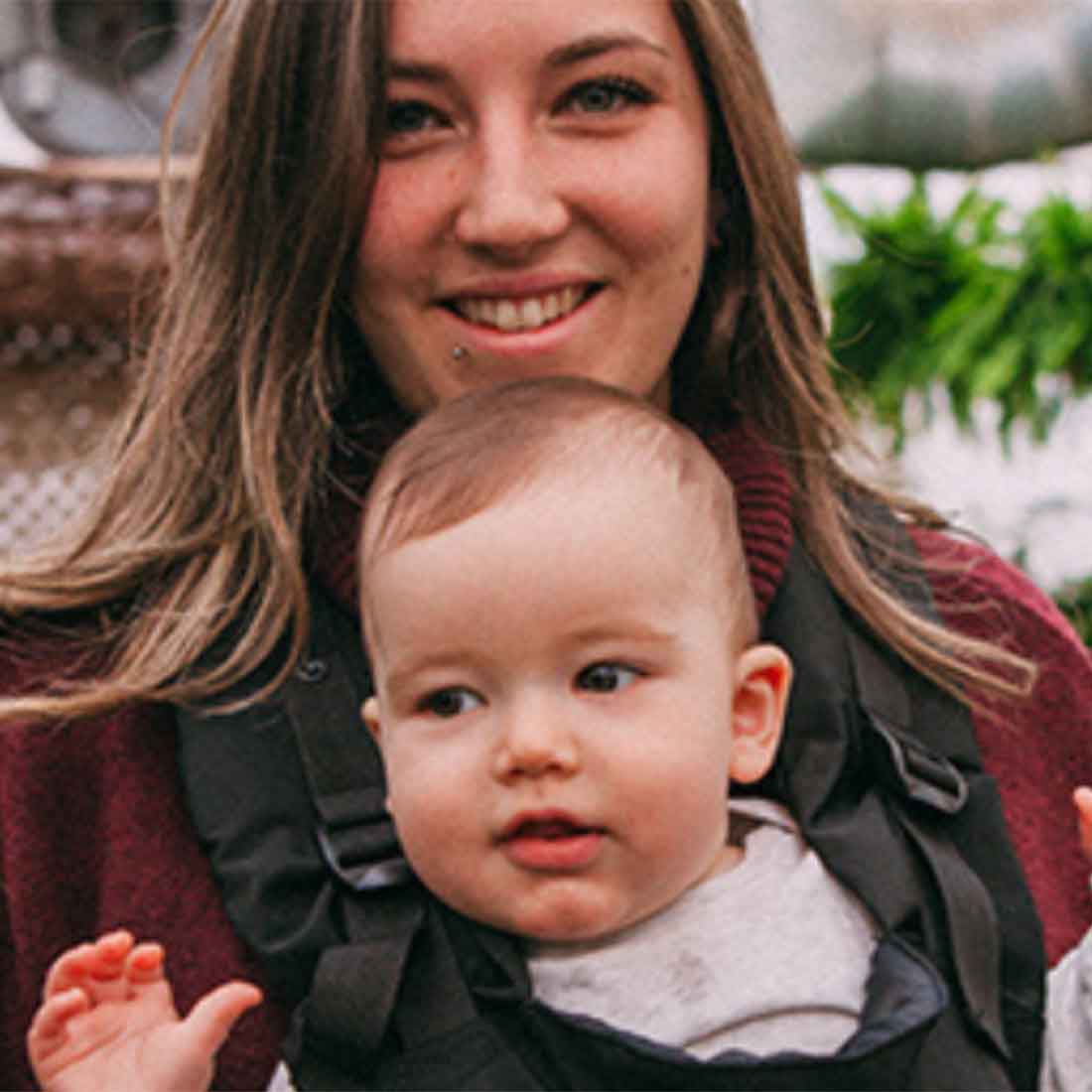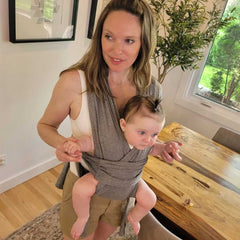Babywearing facing out to the world has many advantages like opening up your baby to other people and his environment. However, this position comes with a lot of concerns regarding its safety, the proper physiological development of babies and their wellbeing. This position can nonetheless still be considered with respect to specific safety precautions.
Several key elements need to be considered:
- Supporting the legs: In the case where the baby’s legs are kept folded instead of free to move, it’s possible to start carrying your baby facing out as soon as the baby can consistently hold his head up, which would be around 3 or 4 months. For a baby to be facing out with his legs out on either side, it’s necessary to wait until he is 6 months old (with the exception of the Multi 2.0, see paragraph 3 below).
- Time limit: Babywearing in a position facing out should be no longer than 20 minutes.
In this article, we’ll enlighten you on the specifics you need to know about this babywearing position to ensure a safe carry, the advantages of carrying facing out and how to choose a baby carrier or baby wrap suitable for it. Lastly, we’ll give you our recommendations to make your baby comfortable and enjoy an agreable moment with your child.
1. What are its advantages and benefits?
Babywearing facing out needs to be done with respect to some measures in order to remain safe and enjoyable, but it remains a wonderful occasion for your baby to open himself to his surroundings by enjoying a broader field of vision. Your child will then benefit from an enriched visual stimulation, which will promote his cognitive development by allowing him to discover new faces, new colors, and new shapes.
Moreover, this position encourages early social interactions, since the baby gets exposed to more people interacting around him, which will be beneficial to his curiosity and awareness.
Furthermore, this position allows parents to share experiences with their child and adds to the development of a strong emotional bond.
2. What are the disadvantages of this position?
There are several reasons why carrying facing out requires to comply with the safety precautions we’ve mentioned previously:
- The baby’s hips can be affected if his legs are improperly supported in this position. The weight of the legs combined to a bad position in extension and adduction can lead to a dislocation of the articulation. To learn more on the topic, you can look up resources from the International Hip Dysplagia Institute. For all of these reasons, obeying the criteria we mentioned is necessary.
- Facing out is very stimulating and tiresome for your baby. When your child is facing outward, he gets exposed to the unknown and to all kinds of visuals. This can become stressful to him. Moreover, he doesn’t have the opportunity to be in your arms and to be reassured by your contact. When placing him in this position, it’s preferable to choose a quiet moment in a familiar environment with few people around. If possible, carry facing out when surrounded with people that your child already knows.
- Your baby’s head isn’t as well supported in this position. This means that the position demands more effort from him to hold his head up, which might tire him faster.
- This position puts more weight on the carrier’s shoulders and back. While carrying face out, the person carrying is more unstable and has more difficulty doing certain movements than in other positions. Indeed, because the baby’s hips are facing out, his weight is pushed farther away from the carrier. This makes the baby feel heavier and more cumbersome.
3. Which baby carrier or baby wrap should you choose?
There are several baby carriers and wraps designed for carrying your baby facing out to choose from.
Here are a few recommendations :
- Structured baby carriers: Our number 1 choice for this position is the Multi 2.0 as it allows for an ergonomic position but also so much more. Of the models presented here, it’s the only one that allows you to carry your baby facing forward as early as 4 months old with the baby’s legs out as it offers great support to the baby.
- Evolutive baby carriers: Our models EvöAir and PöpNgo each allow for many babywearing positions, among which are facing out to the world with the baby legs folded or free, in addition to being adaptable to the baby’s growing size thanks to their evolutive systems.
- The Mei Tai: A perfect compromise between baby wraps and structured carriers, this model offers the possibility to carry your baby with his legs either folded inside the baby carrier or out.
- Lastly, all baby wraps allow for a great diversity of positions including facing out. It’s crucial to be familiar with the ties specific to the facing out carry, making sure that the baby’s back, hips, and head are all properly supported. We’ll give you more details on how to place your baby comfortably in the next paragraph.
4. How can you make your baby comfortable?
Remember to verify from time to time that the blood flow to your baby’s legs is not impeded by the position and make sure not to over stimulate your baby.
With a stretchy wrap two different front-facing positions are possible:
- Facing out with the baby’s legs folded in the wrap: Take a look at this video to see how to set your baby in this position.
- Facing out with your baby’s legs free on either side of the carrier or wrap: This variant of the position is great for children who find having their legs folded is too restrictive. Take a look at this video demonstration.
Une autre écharpe qui peut être utilisée et qui a été spécialement conçue pour les bébés de 18 mois et moins est l’écharpe Snüg. Voyez ici la démonstration de ce modèle.
If you’d like to use a structured carrier, you can watch our videos on facing out positions for the Mei Tai, the Multi 2.0 structured baby carrier and the PöpNgo. These last two demonstrations’ principles can be used for all structured baby carriers that allow carrying facing out.
**************
We hope our advice will allow you to put this position to good use while keeping both you and your baby comfortable and safe. It’s important to trust yourself. By obeying requirements in minimum age, length of time carried, the particulars of this position and placing your baby correctly, everything will be fine. Feel free to share your experience on Chimparoo's Facebook page. You’ll be providing useful input to other parents like you.
For more tips on babywearing, take a look at our other resources on the topic:
- Chimparoo's YouTube page is filled with demonstrations on front facing positions and many others.
- Read our other blog posts on physiological babywearing, the hip carry or even the different types of baby wraps' ties and carries.
- Visit our FAQ which covers basic questions to get parents started on their babywearing journey.







Share:
Andréane Loubier, Doula and Babywearing Instructor
5 Tips to Make Your Life Easier as Parents